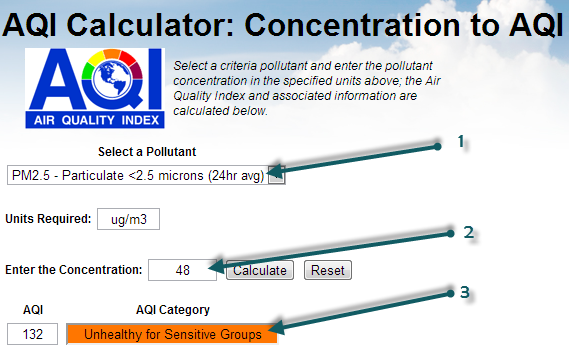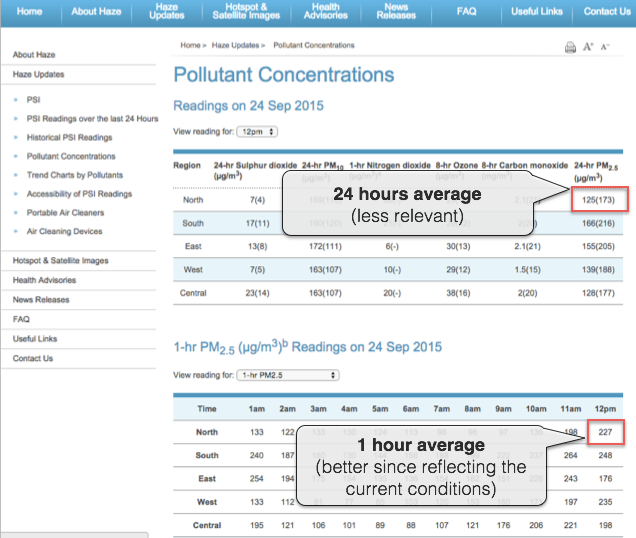In April 2014, the Singapore NEA has updated the PSI calculation to also include PM2.5. http://www.nea.gov.sg/anti-pollution-radiation-protection/air-pollution-control/psi
Cu smogul recent din Asia de Sud-Est din Indonezia care afectează Singapore și acum Malaezia , avem multe întrebări despre de ce există o diferență între datele care pot fi citite de pe site-ul web NEA din Singapore ( nea.gov.sg ) și proiectul World Air Quality Index Singapore pagină web .
De exemplu, iată ce poate fi citit astăzi pe site-ul NEA:

Din anumite motive istorice, Singapore folosește PSI ( Indexul standard al poluanților ) pentru a evalua calitatea aerului. În imaginea de mai sus, numărul 1 corespunde valorii PM10 care este utilizată pentru evaluarea PSI. Valoarea 67(/59) poate fi citită ca 67 μg/m3, corespunzătoare unui PSI de 59. PSI este evaluat ca maximul PSI individual pentru fiecare dintre poluanți: PM 10 , SO 2 , NO 2 , O 3 (Ozon) şi CO2 .
PSI(Singapore-North) = max( PSIPM10-based, ... PSIO3-based )= max (59, ..., 77) = 77
Acestea fiind spuse, lucrul interesant este că, în același tabel, datele PM2.5 sunt furnizate și în ultima coloană (vezi 3). Aceste date sunt furnizate numai în μg/m3 (vezi 2) și nu există nicio conversie la ceva asemănător PSI (adică o conversie de la masa PM2,5 la un indice de poluare sau de calitate). Cu toate acestea, această conversie există și este definită de Agenția pentru Protecția Mediului din SUA . Cel mai simplu mod de a face conversia este să utilizați calculatorul online, disponibil la airnow.gov :

If you select the PM2.5 (1), then enter the mass concentration of 48 (2), can click on Calculate, you will obtain the AQI of 132 (3). So, based on the PM2.5 AQI conversion, the PSI that is used for Singapore could be extended (let's call it PSI++) to also take into account the PM2.5 information. In which case, the PSI++ would be the maximum of the regular PSI (based on PM10 only) and the PM2.5 AQI:
PSI++ = max( PSI, AQIPM.25 ) = max( 77, 132 ) = 132
This PSI++, that is commonly referred as AQI (or Air Quality Index), is what is being used on the the World Air Quality Index project, for all the cities (provided PM2.5 is available for the city). And this explains why the values are different between the NEA website and the World Air Quality Index project.
Moreover, when doing the convertion, make sure you use the 1-hour reading for the PM2.5 concentration rather than the 24-hours averaged value, as shown on the below image:

http://www.haze.gov.sg/haze-updates/pollutant-concentrations/type/PM25-1Hr
If you want to know more about PM10 vs PM2.5, and especially why PM10 is still used, please check the faq entry about why is PM2.5 often higher than PM10? Is PM10 still a relevant measure?
--
For more information about specific countries or continent, please refer to those articles: Thailand and Malysia - India - China - Hong Kong / Canada (Air Quality Health Index) - South America - Australia - Quebec and Montreal - Singapore - Poland - Indonesia .
For information about the 24 hours averaging used or Ozone and Particulate Matter (PM2.5), please refer to those two articles: Ground Ozone Index - PM2.5 Instant Cast
